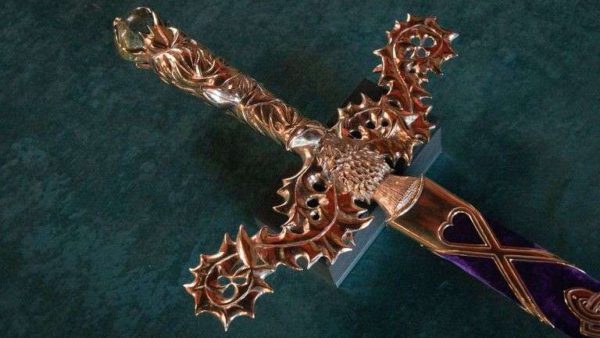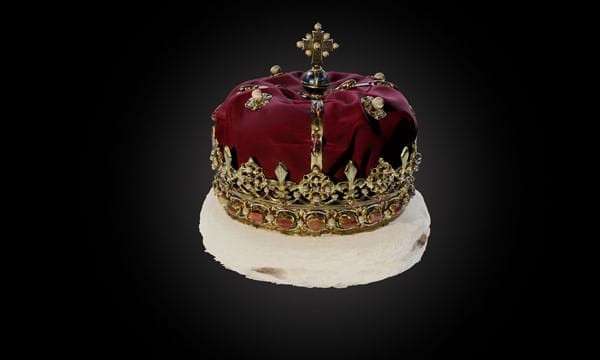Newly released 3D digital models of the Crown of Scotland, the Sceptre and the Sword of State will allow users to explore and examine the intricate detail of the Honours like never before. As well as offering a unique perspective on the Honours, the models will also be used to aid future conservation work. The Honours were digitally captured through a process of photogrammetry, where hundreds of overlapping high-resolution photographs are taken around the objects and then analysed by software to work out their relative position. These aligned photographs are then used to create accurate photorealistic models of the objects.
On 5 July, the Honours were formally presented to King Charles III at the National Service of Thanksgiving and Dedication which took place at St Giles’ Cathedral in Edinburgh. The blade of the Sword of State is in a very fragile condition, having been broken and repaired in the past, likely around the time the Honours were hidden from Cromwell. In order to protect this historic object, it has been retired from use some years ago with consent of the monarch. The Lord Lyon has commissioned a new sword, The Elizabeth Sword, to be made for ceremonial purposes and Historic Environment Scotland (HES) have agreed to care for this new commission.
Immense significance
The Honours of Scotland are objects of immense significance and have been present at many of the major royal ceremonial events over the past five centuries. Their centrepiece is the Crown of Scotland, crafted of gold and silver and laden with 94 pearls and 43 gemstones including diamonds, garnets and amethysts. James V had the Crown made in 1540, likely in part from the earlier Scottish Crown which had been damaged, and first wore it at the coronation of Mary of Guise that same year.
The Sceptre is thought to have been a gift to James IV from Pope Alexander VI in 1494. This ceremonial staff is an example of High Renaissance Italian craftsmanship, with the finial formed from a globe of polished rock crystal and held up by stylised dolphins and three figures depicting St Andrew, St James and the Virgin Mary. On top of the crystal globe sits a gold orb, capped with a single large pearl.
The Sword of State was gifted to James IV by Pope Julius II in 1507 and represents an exceptionally high quality of decoration. The arms of Pope Julius were used as the theme for the Sword handle design, with oak trees and acorns symbolising the risen Christ and dolphins signifying Christ’s Church. The blade of the Sword is in a very fragile condition and was retired from use some years ago with consent of the monarch.
Kathy Richmond, Head of Collections and Applied Conservation at HES, said: “Using digital technology in this way can help enhance how we enjoy, understand and protect the precious objects of our past.”
Turbulent history
The Honours of Scotland have had a turbulent history. Edward I had removed the former Honours of Scotland along with the Stone of Destiny in 1296, with only the Stone surviving. The Honours seen today were pursued by Cromwellian forces, who destroyed the English Crown Jewels. In 1650 they were removed for safekeeping ahead of Oliver Cromwell’s siege of Edinburgh Castle. Unable to be returned to Edinburgh Castle following the Scottish coronation of King Charles II in 1651, the Honours were taken to Dunnottar Castle before being smuggled out during a siege and hidden at Kinneff Kirk. Only with the restoration of King Charles II to the throne could they return to Edinburgh Castle and be used for ceremonial openings of Parliament until 1707.
With the Parliamentary Union of 1707, the Honours were locked away in the Crown Room at the Castle, as they were no longer needed for ceremonial events. They remained there until 1818 when Walter Scott and others, with a royal warrant from the Prince Regent (who would become George IV), broke into the Crown Room, opened the Crown Chest and there rediscovered the Honours.
The digital models of the Honours of Scotland are available to view on Sketchfab: https://sketchfab.com/HistoricEnvironmentScotland/collections/honours-of-scotland
Did you know?
The Elizabeth Sword

-Is a new sword of state was used in Coronation service.
-Named after the late Queen Elizabeth II, the ceremonial sword was presented to the King along with the Crown and Sceptre which are part of the Honours of Scotland – Scotland’s Crown Jewels – during the National Service of Thanksgiving and Dedication at St Giles Cathedral on Wednesday 5 July.
-Following the service, the sword and Honours were returned to the care of Historic Environment Scotland.
-Designed by former Ormond Pursuivant of Arms Mark Dennis and worked on by a number of expert Scottish craftspeople, the sword features a pommel of Lewisian gneiss, and a scabbard wrought from Perthshire oak.
-The sword will be used on ceremonial occasions in place of the current sword, gifted to James IV by Pope Julius in 1507, which can no longer be used due to its fragile condition.
The Honours of Scotland
-The Honours of Scotland, comprising the Crown of Scotland, the Sceptre, and the Sword of State, are the oldest Crown jewels in Britain.
-The Honours of Scotland are owned by the Crown, i.e. King Charles III, and are on loan from the Commissioners for the Safeguarding of the Regalia, who are appointed by Royal Warrant. HES acts on their behalf to care for the Honours of Scotland and the Stone of Destiny.
-The Honours were formally presented to Queen Elizabeth at the last National Service of Thanksgiving which took place in 1953 at the High Kirk of St Giles’ in Edinburgh, before being returned to their custodians. The National Service of Thanksgiving and Dedication on 5 July 2023 will repeat this tradition.
-The Honours of Scotland will be escorted from Edinburgh Castle to St Giles’ Cathedral by The King’s Body Guard for Scotland, the Royal Company of Archers and a Guard of Honour formed by contingents of the Navy, Army and Royal Air Force. The Stone of Destiny will be placed in St Giles’ in advance of the Service in a non-public move.
Following the service, the Honours returned to display alongside the Stone of Destiny in the Crown Room at Edinburgh Castle.
Main photo: The Honours of Scotland – the oldest Crown jewels in Britain and among the oldest in Europe – have been digitised by HES.

